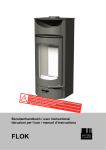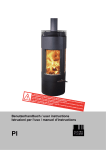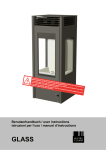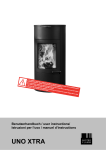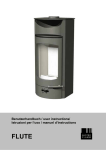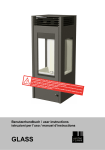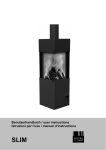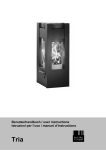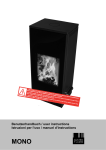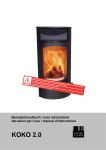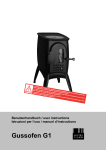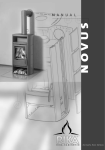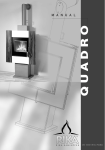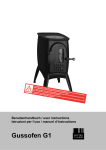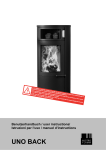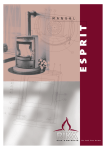Download Manuel d`instruction
Transcript
Benutzerhandbuch / manual / manuale / manuel Benutzerhandbuch / user instructions/ Istruzioni per l’uso / manuel d’instructions Fig. 1 FLOK Fig. 1 c b a Fig. 2 deutsch AUF – ZU Sekundärluftschieber Primärluftschieber english open – closed secondary air supply primary air supply italiano aperto – chiuso regolazione aria secondaria regolazione aria primaria deutsch Inhalt english Contents italiano Indice 1. Techn. data 4 2. Important information 4 3. Correct operation of your stove 5 4. The most important spare parts - overview 6 Guarantee 13 1. Dati tecnici 2. Informazioni importanti 3. Per un uso corretto della vostra Kaminofen 4. Prospetto dei ricambi principali Garanzia 1. Techn. Daten 2. Wichtige Informationen 3. So bedienen Sie Ihren Kaminofen richtig 4. Die wichtigsten Ersatzteile - Übersicht Garantie 1 1 2 3 13 français ouvert - fermé coulisseau d’entrée d’air second. coulisseau d’entrée d’air primaire français sommaire 7 7 8 9 14 1. Caractéristiques 2. Infos importantes 3. Bien utiliser votre poêle 4. Principales pièces détachées Garantie 10 10 11 12 14 deutsch 1 Flok 1. TECHNISCHE DATEN Als Kaminofen der Bauart 1 ist ein Anschluß an einen bereits mit anderen Öfen und Herden für feste Brennstoffe belegten Schornstein möglich, sofern die Schornsteinbemessung gemäß DIN 4705, Teil 3, Kleinste Heizleistung Raumheizvermögen (abhängig von der Hausisolierung) 2,5 kW 34 – 88 m³ dem nicht widerspricht. TECHNISCHE DATEN Höhe Breite Tiefe Gewicht mit Stahlmantel Rauchrohrabgang Durchmesser Nennwärmeleistung lt. EN 13240 Maximale Heizleistung Abgaswerte für die Mehrfachbelegung des Schornsteines nach DIN 4705, Teil 3 bzw. zur Bemessung des Schornsteines nach DIN 4705, Teil 2 Abgasmassenstrom geschlossen 3,7 g/s Abgastemperatur geschlossen 317 °C Mindestförderdruck bei geschlossen 10 Pa 958 mm 433 mm 417 mm 110 kg 130 mm 4 kW 6 kW Nennwärmeleistung (NWL) bei 0,8facher NWL 8 Pa 2. WICHTIGE INFORMATIONEN in diesem Handbuch sind Nationale und europäische Normen, örtliche und baurechtliche Vorschriften sowie feuerpolizeiliche Bestimmungen sind einzuhalten. Allgemeine Sicherheitshinweise zum Betrieb Ihres Kaminofens • Lesen Sie vor der Inbetriebnahme des Ofens das gesamte Handbuch gründlich durch und beachten Sie die Warnhinweise. • Für den Transport Ihres Heizgerätes dürfen nur zugelassene Transporthilfen mit ausreichender Tragfähigkeit verwendet werden. • Das Abstellen von nicht hitzebeständigen Gegenständen auf dem Heizgerät oder in dessen Nähe ist verboten. • Legen Sie keine Wäschestücke zum Trocknen auf den Ofen. Auch Wäscheständer oder dgl. müssen in ausreichendem Abstand vom Heizgerät aufgestellt werden – Brandgefahr. • Der Kaminofen Flok ist keine DauerbrandFeuerstelle. • Beim Betrieb Ihres Heizgerätes ist das Verarbeiten von leicht brennbaren und explosiven Stoffen im selben oder in anschließenden Räumen verboten. • Ihr Heizgerät ist nicht zur Verwendung als Leiter oder Standgerüst geeignet. Kaminofenaufstellung • Beachten Sie, dass sich Oberflächen des Kaminofens während des Betriebes stark erwärmen. Zur Bedienung des Kaminofens empfehlen wir die Benützung des Schutzhandschuhs. Machen Sie Kinder auf diese Gefahren aufmerksam und halten Sie sie während des Betriebes von der Feuerstätte fern. (Mindestabstände - siehe auch Typenschild) Fig. 2 a > 800 mm b > 150 mm c > 100 mm (a - nach vorne im Strahlungsbereich) (b - seitlich) (c – hinten) • Verbrennen Sie ausschließlich das im Kapitel „saubere Verbrennung“ angeführte, genehmigte Heizmaterial. • Das Verbrennen oder Einbringen von leicht brennbaren oder explosiven Stoffen, wie leere Spraydosen und dgl. in den Brennraum, sowie deren Lagerung in unmittelbarer Nähe Ihres Heizgerätes, ist wegen Explosionsgefahr strengstens verboten. • Beim Nachheizen sollen keine weiten oder leicht brennbaren Kleidungsstücke getragen werden. Einzuhaltende Sicherheitsabstände Bitte beachten Sie, dass der Aufstellungsraum mind. eine Türe / ein Fenster ins Freie aufweist oder mit einem derartigen Raum direkt verbunden sein muss. Andere Feuerstätten und Dunstabzugshauben dürfen nicht im Raumluftverbund mit Feuerstätten betrieben werden. Technische und optische Änderungen, Satz- und Druckfehler vorbehalten. Die Informationen allgemeiner Natur. Flok 2 Bodentragfähigkeit Prüfen Sie vor dem Aufstellen, ob die Tragfähigkeit der Unterkonstruktion dem Gewicht Ihres Kaminofens standhält. Verbrennungsluft Als Betreiber müssen Sie für ausreichende Verbrennungsluft sorgen. Bei abgedichteten Fenstern und Türen kann es sein, daß die Frischluftzufuhr nicht mehr gewährleistet ist bzw. das Zugverhalten des Ofens beeinträchtigt wird. Ggf. muss für eine deutsch zusätzliche Frischluftzufuhr gesorgt werden. Bitte befragen Sie Ihren Fachhändler. Rauchrohranschluß Für den Anschluß der Rauchrohre an den Schornstein gibt es zu Ihrer eigenen Sicherheit strenge Richtlinien. Ihr Kaminofen-Fachhändler kennt diese. Beauftragen Sie daher unbedingt Ihren Fachhändler mit dem Rauchrohranschluß. 3. SO BEDIENEN SIE IHREN KAMINOFEN RICHTIG Zugelassene Brennstoffe Trockenes, gut abgelagertes, naturbelassenes Holz (Hartholz bevorzugt), Holzbriketts. Maximale Brennstoffmenge c Maximal aufzugebende Brennstoffmenge: 1,3 kg Holz. Größere Brennstoffmengen können zu Überhitzung und Beschädigungen am Ofen führen! b Saubere Verbrennung a Richtig Feuer machen Für den richtigen und sicheren Betrieb der Feuerstätte ist darauf zu achten, dass der Schornstein den erforderlichen Förderdruck aufbaut. Dies muss besonders bei jeder Erstinbetriebnahme (z.B. nach der Sommerzeit) und in der Übergangszeit (z.B. bei starkem Wind) kontrolliert werden. Fig. 4: Luftschieber regulieren Sobald die Holzscheite rundherum gut brennen, können Sie mit dem Luftschieber die Heizleistung regulieren (Regler auf Maximalstellung „+“ = maximale Heizleistung), die Flammen sollten aber immer gelb und nie blau brennen (sonst wieder mehr Luft zuführen) – siehe Fig. 4. Regler der Verbrennungsluft ganz nach links auf Stellung „+“ bringen. Legen Sie 2 – 3 Stück Scheitholz nach unten (1), das Anzündholz (2) darüber. Darauf legen Sie in die Mitte eine Anzündhilfe (3) und zünden diese an (siehe Fig. 3).! Beim Nachlegen gehen Sie prinzipiell wie beim Anheizen vor: Luftregler auf „+“ stellen, Ofentüre vorsichtig öffnen, Holz nachlegen, Türe schließen. Warten Sie bis das nachgelegte Holz brennt. Regeln Sie in der Folge die Heizleistung mit dem Regler.. 2 3 Heizen in der Übergangszeit 1 Fig 3: Anzünden Schließen Sie die Türe! In der Übergangszeit, d.h. bei höheren Außentemperaturen, kann es bei plötzlichem Temperaturanstieg zu Störungen des Schornsteinzuges kommen, so dass die Heizgase nicht vollständig abgezogen werden. Die Feuerstätte ist dann mit geringeren Brennstoffmengen zu befüllen und bei weiter geöffnetem Primärluftschiebers/-reglers so zu betrieben, dass der vorhandene Brennstoff schneller (mit Flammentwicklung) abbrennt und dadurch der Schornsteinzug stabilisiert wird. Symbolabbildungen Das Brennholz muß trocken (rel. Holzfeuchte < 15 %) und unbehandelt sein. Außerdem muß die richtige Brennholzmenge verbrannt werden, um eine saubere, emissionsarme Verbrennung zu erreichen. deutsch 3 Flok Hinweis bei Schornsteinbrand Wird falscher oder zu feuchter Brennstoff verwendet, kann es aufgrund von Ablagerungen im Schornstein zu einem Schornsteinbrand kommen. Verschließen Sie sofort alle Luftöffnungen am Kamin und informieren Sie die Feuerwehr. Nach dem Ausbrennen des Schornsteins diesen vom Fachmann auf Risse bzw. Dichtheit überprüfen lassen. 4. DIE WICHTIGSTEN ERSATZTEILE - ÜBERSICHT Keramott Bezeichnung Keramott Boden links Keramott Boden rechts Keramott Holzfänger Keramott Rückwand Keramott Seite links Keramott Seite rechts Keramott Umlenkplatte Rost Nr.-Skizze Artikelnr. 1 714930 2 714931 3 714932 4 714933 5 714934 6 714935 7 714936 8 716408 Sonstiges Bezeichnung Flok Tür Flokgriff komplett Flok BA1 Feder Flok Türglas Glasreiniger 0,5l Ofenlack Austroflamm Anzünder Dose à 100 St. Nummerierung Keramott = Einbaureihenfolge Nr.-Skizze Artikelnr. 9 714973-29 10 714466 11 714990-15 12 714920 -640070 -650002 -640162 Dichtungen Bezeichnung Flachdichtung 8mm x 2mm (1,7m) Runddichtung Ø 8mm (0,5m) Runddichtung Ø 14mm (1,8m) Nr.-Skizze Artikelnr. 13 710096 14 710696 15 718429 Zubehör Bei Ihrem Fachhändler erhalten Sie Bodenplatten aus Glas oder Stahl, Pflegemittel oder das Heat Memory System zur Wärmespeicherung. WICHTIG: Lassen Sie defekte Teile ausschließlich von Ihrem Kaminofenfachhändler austauschen. Damit ist gewährleistet, daß Ihr Kaminofen sicher und funktionstüchtig ist und bleibt. Die Feuerstätte darf nicht verändert werden. Pflege Zur Glasreinigung verwenden Sie bitte ein Spezialprodukt wie Thermohit Glasreiniger. Lackierte Oberflächen dürfen nur mit einem Tuch (ev. feucht) gereinigt werden. Für Edelstahloberflächen gibt es ebenfalls Spezialreiniger. Reinigung Der Kaminofen, Rauchgaswege und Rauchrohre sollten jährlich – evtl. auch öfter, z.B. nach der Reinigung des Schornsteines – nach Ablagerungen untersucht und ggf. gereinigt werden. Der Schornstein muss ebenfalls regelmäßig durch den Schornsteinfeger gereinigt werden. Über die notwendigen Intervalle gibt Ihr zuständiger Schornsteinfegermeister Auskunft. Der Kaminofen sollte jährlich durch einen Fachmann überprüft werden. Flok 4 english 1. TECHNICAL DATA As a stove of construction type 1, it is possible to connect it to the chimney together with an existing other stove or another hearth for solid fuels, as long as the chimney calculation complies with DIN 4705, Part 3. TECHNICAL DATA Height Width Depth Weight Flue pipe outlet diameter Nominal thermal output (EN 13240) Maximum thermal capacity Smallest heating capacity 958 mm 433 mm 417 mm 110 kg 130 mm 4 kW 6 kW 2,5 kW Room heating capacity (depending on 34 - 88m³ building insulation) Exhaust values for multiple use of the chimney in accordance with DIN 4705, Part 3 and for the calculation of the chimney measurements in accordance with DIN 4705, Part 2 Fluegas mass flow closed 3,7 g/s Fluegas temperature closed 317 °C Minimum feed pressure closed 10 Pa Nominal thermal output at 0.8 times n. ther. outp. 8 Pa 2. IMPORTANT INFORMATION standards, local and building regulations as well as fire prevention laws must be observed during the operation of the stove. General safety instructions for the operation of your stove • Read the entire manual before starting up your stove thoroughly and observe the caution notices. • Your heating unit must not be moved without approved means of transport with sufficient loadbearing capacity. • Your heating unit is not suitable to be used as a stand or as a ladder. • Please keep in mind that your stove’s surface heats up considerably during operation. We therefore recommend wearing a safety mitten when operating your stove. • Make your children aware of this particular danger and keep them at a distance from the heating unit whenever it is in operation. • Only burn approved fuels and materials as listed in the chapter “Clean Burning”. • The burning or placing of flammable or explosive materials, such as empty spray cans, etc. into the firebox as well as the storage of such materials in the immediate vicinity of your heating unit is strictly forbidden due to the danger of explosion. • Do not wear loose or flammable clothing when adding fuel to the fire. • Placing non-heat-resistant objects on the heating unit or in the vicinity of the heating unit is forbidden. • Do not lay laundry onto the stove for drying. Laundry hung up to dry must be kept at a safe distance from the stove because of the danger of fire. • The wood stove Flok is not suitable for long term heating. • During the operation of your heating unit it is forbidden to use flammable or explosive materials in the same or an adjacent room to the one in which your heating unit is located. Setting up your stove Required safety distances (Minimum distances – see name plate - in Fig. 2) a > 800 mm b > 150 mm c > 100 mm (a – toward the front in the radiated area) (b – to the side) (c – to the back) Make sure that the room in which the stove is set up has at least one door or window into the outside or is directly adjacent to such a room. Other fireplaces and extractor hoods must not be operated in the same room as the stove. Subject to technical and optical modifications. Formatting and printing errors excepted. The installation and operation information given here is of general nature. National and European english 5 Floor load capacity Make sure that the load capacity of the supporting construction is sufficient to carry the weight of the entire unit, before the heating unit is installed. Combustion air Being the user of the stove you must take care of a sufficient combustion air supply. Sealed-up windows and doors may not allow a sufficient combustion air supply or disturb the draught behaviour of your stove. Please ensure the additional supply of fresh Flok combustion air if necessary. For details please consult your specialist retailer Stove pipe connection For your own safety stringent laws apply for connecting the stove pipes to the chimney. Your professional dealer or distributor knows these laws. Please have your certified retailer carry out the connection of your stove. 3. CORRECT OPERATION OF YOUR STOVE Approved fuels Dry, well cured and natural wood (hardwood preferred), wood briquettes. Maximum amount of fuel c Maximum amount of fuel to be added: 1,3 kg wood. Larger amounts of fuel can lead to overheating and thus damage the stove. b Clean burning a The wood must be dry (relative wood moisture < 15%) and untreated and the right amount of wood must be burned in order to ensure a clean fire that releases only small amounts of emissions. Making a fire For the correct and safe operation of your stove please pay attention of the chimney developing the necessary feed pressure. This must especially be considered before the initial operation (or e.g. after the summer heating break) and during the midseason heating periods (e.g. at strong wind, etc.). Turn the air control knob to the left “+” position. 2 3 1 Figure 3: igniting the fire symbol figures Put 2-3 logs of wood at the firebox bottom (1) and put the kindling (2) on top. Place a wood lighter aid on top and in the middle of the kindling, light it (see fig. 3) and close the door. Figure 4: air control knob As soon as the surrounding logs are burning well enough you can start controlling the heat output (control knob on maximum “+” = maximum heat output). The flames shall always look yellow and never blue (otherwise please add more air) – see fig. 4. The recharging is principally done the same as the starting up of the stove: turn the air control knob to the maximum “+” position, open stove door CAREFULLY, place wood in the firebox cautiously, close door. Wait until the newly added wood is burning properly and subsequently control the heat output by adjusting the air knob as desired. Heating in-between seasons If you heat the stove in between seasons, when the outside temperatures are higher, the flue gases may not be able to escape completely and this may lead to disturbances in the chimney draught, especially if the temperatures are rising suddenly. The stove has to be charged with less wood then and the primary air has to be increased so that the wood can burn down faster (with visible flames) and thus the chimney draught can stabilize. Flok 6 english Chimney fire A chimney fire may occur, due to sooting and deposits in the chimney, if wrong or humid fuel is used. In case of a chimney fire close all air inlets on the fireplace/chimney immediately and call the fire brigade. Please have an expert inspect your chimney for cracks and air-tightness after the burning out of the chimney. 4. THE MOST IMPORTANT SPARES—OVERVIEW Gaskets Description Flat gasket 8x2 mm (1,7 m) Gasket round Ø= 8 mm (0,5 m) Gasket round Ø= 14 mm (1,8 m) Nr.drawing Part number 13 710096 14 710696 15 718429 Keramott Description Bottom left, Keramott Bottom right, Keramott Wood retainer, Keramott Rear, Keramott Side component left, Keramott Side component right, Keramott Baffle plate, Keramott Grate Nr.drawing Part number 1 714930 2 714931 3 714932 4 714933 5 714934 6 714935 7 714336 8 716408 Keramott numbering = installation instructions! Other parts Description Flok door Door handle Flok BA1 door spring Flok door glass Glass cleaner ½ litre Stove lacquer Wood lighter can à 100 pcs. Nr.drawing Part number 9 714973-29 10 714466 11 714990-15 12 714920 -640070 -650002 -640162 Accessories You can obtain floor plates of glass or steel, care products or the Heat Memory System for heat storage from your certified dealer. IMPORTANT: Have defective parts replaced by your certified dealer. This will guarantee that your stove functions properly and safely. The fireplae must not be amended. Maintenance To clean the glass, please use a specialized product such as Thermohit glass cleaner. Lacquered surfaces are to be cleaned only with a cloth (may be damp). Special cleaning agents should also be used for stainless steel surfaces. Cleaning The stove, flue outlets and smoke pipes should be cleaned and inspected for deposits every year – if necessary more often, e.g. after the cleaning of the chimney. The chimney also has to be cleaned regularly by the chimneysweeper. Your chimneysweeper will inform you of the necessary inspection intervals. An expert should inspect the stove annually. italiano 7 Flok 1. DATI TECNICI Questa stufa-caminetto (Kaminofen del tipo Bauart 1) è adatta per essere collegata ad una canna fumaria già utilizzata per altre stufe o fonti di calore che impiegano combustibili solidi, se le dimensioni della canna fumaria lo consentono (norma DIN 4705, Parte 3). DATI TECNICI Altezza Larghezza Profondità Peso Diametro uscita fumi Rendimento nominale (secondo DIN 18891) 958 mm 433 mm 417 mm 110 kg 130 mm 4 kW Rendimento massimo 6 kW Rendimento minimo Volume riscaldabile (dipende dalle condizioni di isolamento ) 2,5 kW 34 – 88 m³ Valori delle emissioni per allacciamento multiplo alla canna fumaria (secondo norma DIN 4705, Parte 3) e per il calcolo delle dimensioni della canna fumaria (secondo DIN 4705, Parte 2) Flusso fumi chiuso 3,7 g/s Temperatura fumi chiuso 317 °C Depressione minima chiuso 10 Pa con rendimento Con potenza calorifica con r.nom. di 8 Pa nominale di 0,8 volte 0,8 volte Questo manuale contiene informazioni generali. Devone essere rispettate sia le norme nazionale e europee, le disposizioni locali e le leggi sul edilizia ed anche le disposizioni dei vigili del fuoco. Avvertenze generali e precauzioni nell'impiego della Kaminofen • Prima di mettere in funzione la stufa vi raccomandiamo di leggere attentamente l'intero manuale che vi fornisce importanti informazioni e avvertimenti. • Per il trasporto della stufa utilizzate mezzi idonei, la cui portata sia sufficiente a sostenerne il peso. • Non utilizzate la stufa come se fosse una scala o un'impalcatura per salirvi sopra. • Attenzione ! Durante il funzionamento, la superficie del apparecchio si riscalda. In caso di contatto consigliamo l'utilizzo di un apposito guanto durante il funzionamento. • Istruite i vostri bambini su questi inconvenienti e teneteli lontani dalla stufa quando è accesa. • Utilizzate solo i combustibili indicati nel capitolo „Combustibili adatti“. • Nella camera di combustione non devono essere infilate e bruciate sostanze facilmente infiammabili od esplosive, come bombolette spray vuote e simili. E’ severamente vietato lasciare tali oggetti nelle immediate vicinanze della stufa (pericolo di esplosione). • Mentre si ricarica legna nella stufa accesa è sconsigliato portare capi di abbigliamento che possano prendere fuoco facilmente. • Non appoggiate oggetti non resistenti al calore sulla stufa o nelle sue immediate vicinanze. • Non mettete ad asciugare biancheria sopra la stufa. • Stendibiancheria o simili devono essere collocati ad una distanza adeguata dalla stufa (pericolo di incendio). • La stufa non e una stufa da tenere in funzione ininterrotamente. • Quando la stufa è in funzione è sconsigliato l’ utilizzo di sostanze facilmente infiammabili o esplosive nella stessa stanza o in stanze adiacenti. Installazione della stufa Distanze di sicurezza (distanze minime) Fig. 2 a > 800 mm b > 150 mm c > 100 mm (a – anteriormente nell’area di irradiazione) (b – lateralmente) (c – posteriormente Il luogo in cui installate la stufa deve disporre di almeno una porta / finestra che dia all’esterno oppure deve essere collegato direttamente ad un ambiente con accesso all’esterno. Non devono essere messi in funzione nella stessa stanza, altre stufe, caminetti o estrattori fumi. Salvo modifiche di carattere tecnico ed estetico o errori di fotocomposizione e stampa. 2. INFORMAZIONI IMPORTANTI Flok 8 Portata del pavimento Prima di installare la stufa, accertatevi che la struttura sottostante al punto in cui volete sistemarla sia in grado di sopportarne il peso. Fornimento d'arai fresca Il gestore del focolare deve garantire la fornitura di un sufficiente volume d'aria fresca. In ambienti con porte e finestre chiuse ermeticamente la fornitura d'aria fresca non sempre e'garantita. Questo puo influenzare il tiraggio del focolare. Eventualmente italiano deve essere previsto un aflusso d'aria supplementare. Rivolgetevi al vostro rivenditore per ulteriori informazioni. Collegamento del tubo di uscita fumi Per garantire la vostra sicurezza, il collegamento dei tubi di uscita fumi alla canna fumaria è regolato da apposite norme. Per l’installazione e il collegamento rivolgetevi quindi al vostro rivenditore, che è a conoscenza di tali disposizioni. 3. PER UN USO CORRETTO DELLA VOSTRA KAMINOFEN Combustibili adatti Legna naturale e non trattata, secca e sufficientemente depositata (preferibilmente legno resistente/ duro), tronchetti di legno pressato, bricchetto di lignite. Quantità massime di combustibili La massima quantità di combustibile consigliata: 1,3 kg di legna per volta. Non introducete quantità eccessive di combustibile per evitare un surriscaldamento ed un conseguente danneggiamento della stufa. Quando i ceppi avranno cominciato ad ardere bene, potete regolare il rendimento della stufa con la levetta dell’aria secondaria ( regolazione della levetta in posizione massima “+” corrisponde ad un rendimento massimo), prestando attenzione che la fiamma sia sempre gialla e mai blu ( altrimenti aumentate nuovamente il grado di alimentazione dell’ aria comburente) – vedi fig. 4. c Combustione ed ecologia Per ottenere una combustione corretta con un minimo di emissioni la legna deve essere secca (< 15 % di umidità relativa) e non trattata e non si devono superare le quantità di combustibile consigliate. Per una corretta accensione lIl. 4 : Regolazione dell’aria secondaria Per un utilizzo corretto e sicuro della vostra stufacaminetto occorre prestare attenzione che all’interno della canna fumaria si sviluppi un tiraggio adatto. Soprattutto durante ogni prima accensione (per esempio dopo il periodo estivo) e durante le stagioni transitorie di primavera e autunno (per esempio sotto condizioni di forte vento) questo controllo è molto importante. Posizionate la regolazione dell’aria di combustione del tutto a sinistra in posizione „+“ . Disponete 2- 3 ceppi di legna sul fondo della camera di combustione (1), disponete poi i trucioli per l’accensione (2) al di sopra. Posizionate poi in alto al centro l’accendifuoco (3) e procedete con l’accensione (vedi fig. 3). Chiudete la porta. 2 3 1 lIl. 3 : Accensione b a Durante il caricamento della legna procedete secondo le indicazioni dell’accensione: Posizionate la regolazione dell’aria di combustione in posizione „+“ , aprite lentamente la porta , caricate la legna e richiudete la porta. Quando i ceppi avranno cominciato ad ardere Potete regolare il rendimento della vostra stufa con l’apposita levetta dell’aria secondaria. Il riscaldamento durante le mezze stagioni Se accendete la stufa durante le mezze stagioni, quando le temperature sono più elevate, possono sussistere condizioni di tiraggio sfavorevolli in modo tale da non evacuare il fumo interamente, specialmente se le temperature si alzano in modo repentino. Consigliamo quindi di caricare meno legna e di tenere la presa d'aria aperta del tutto per permettere una combustione più rapida, con una fiamma più alta. In tal modo il tiraggio della canna fumaria si stabilisce. italiano Autocombustione fumaria 9 della Flok canna Fuliggine e depositi causati da legna inadeguata o troppo umida possono provocare l'autocombustione della canna fumaria. Chiudete immediatamente tutte le prese d'aria presenti su stufa e camino e chiamate i vigili del fuoco. Fate poi ispezionare la vostra canna fumaria da personale specializzato che ne verifichi le crepe e la tenuta. 4. PROSPETTO DEI RICAMBI PRINCIPALI Guarnizioni Denominazione Guarnizione piatta 8x2 mm (1,7 m) Guarnizione tonda Ø= 8 mm (0,5 m) Guarnizione tonda Ø= 14 mm (1,8 m) N. su dis. 13 14 15 N. art. 710096 710696 718429 N. su dis. 1 2 3 4 5 6 7 8 N. art. 714930 714931 714932 714933 714934 714935 714936 716408 Keramott Denominazione Keramott di basa sinistra Keramott di basa destra Keramott fermalegna Keramott posteriore Keramott lateral sinistra Keramott lateral destra Keramott tagliafiamme Griglia Numerazione dei refrattari = ordine da seguire per il montaggio! Altre parti Denominazione Porta Maniglie Mola Flok vetroceramico antina Detergente vetroceramico 0,5 l Vernice Accendifuoco N. su dis. N. art. 9 714973-29 10 714466 11 714990-15 12 714920 -640070 -650002 -640162 Accessori Presso il vostro rivenditore potete acquistare basi di protezione in vetro o acciaio, prodotti per la cura e pulizia ed anche l` Heat Memory System per l’accumulazione termica. IMPORTANTE: per la sostituzione di parti difettose rivolgetevi esclusivamene al vostro rivenditore di Kaminofen, in questo modo avrete la garanzia che la vostra stufa continuerà a funzionare in modo corretto e sicuro. Il focolalere non deve essere modificato. Pulizia Per la pulizia del vetro ceramico dell'antina utilizzate gli appositi prodotti in vendita presso i rivenditori di stufe (ad es. Thermohit). Le superfici laccate della stufa vanno pulite solamente con un panno (eventualmente umido). Anche le superfici in acciaio inox vanno trattate con gli appositi detergenti. Stufa, uscite fumi e tubi dovrebbero essere controllati e puliti ogni anno - anche più spesso, se necessario, per esempio in seguito alla manutenzione della canna fumaria, che dev'essere anch'essa eseguita periodicamente dal servizio spazzacamino. Sarà proprio il vostro spazzacamino ad indicarvi i regolari intervalli per la manutenzione. Personale specializzato dovrebbe ispezionare la stufa annualmente. Flok 10 français 1. CARACTÉRISTIQUES TECHNIQUES Le poêle de type 1 peut être raccordé à une cheminée déjà occupée par d’autres poêles ou cuisinières à combustibles solides, à condition toutefois que les dimensions de la cheminée selon la norme DIN 4705 Partie 3 l’autorisent. CARACTÉRISTIQUES TECHNIQUES Hauteur 958 mm Largeur 433 mm Profondeur 417 mm Poids 110 kg Diamètre à la base du carneau 130 mm Puissance calorifique selon EN 13240 4 kW Puissance calorifique maximale 6 kW Puissance calorifique minimale 2,5 kW Volume chauffé (selon 34 - 88 m³ l’isolation du bâtiment) Caractéristiques des gaz de combustion en vue de l’installation de plusieurs appareils sur une cheminée selon DIN 4705 Partie 3 ou du dimensionnement de la cheminée selon DIN 4705 Partie 2 Débit de gaz de fermé 3,7 g/s combustion Température des gaz fermé 317 °C de combustion Pression d’extraction fermé 10 Pa minimale à la puissance nominale à 0,8 fois la puissance nominale 8 Pa Les informations dans ce manuel, sont présentées d’une façon générale. Les normes nationales et européennes, les directives de construction régionales ainsi que les accords concernant la sécurité incendie sont à respecter. Remarques générales concernant la sécurité • • • • • • • Lisez attentivement l’ensemble du manuel avant de mettre le poêle en service et respectez les avertissements relatifs à la sécurité. Le transport de l’appareil doit toujours être effectué au moyen d’un appareillage de capacité suffisante. Le poêle ne doit pas être utilisé comme marchepied ou estrade. Merci de prêter attention à la surface du poêle qui devient trés chaude pendant son fonctionnement. Nous recommandons d’utiliser le gant de protection. Expliquez bien le risque de brûlures à vos enfants et tenez-les éloignés de l’appareil lorsque celui-ci fonctionne. Utilisez toujours le combustible autorisé selon le chapitre « Combustion non polluante ». La combustion ou l’introduction de matières très inflammables ou explosives dans le foyer, par exemple de bombes aérosols vides, est strictement interdite en raison du risque d’explosion, de même que la conservation de tels produits à proximité de l’appareil. • • • • • • Ne rechargez pas le poêle alors que vous portez des vêtements amples ou en matières inflammables. Il est interdit de déposer des objets ne résistant pas à la chaleur sur l’appareil ou à proximité. Ne faites pas sécher de linge sur le poêle. Les étendages et égouttoirs à linge ou autres doivent être placés suffisamment loin de l’appareil pour éviter tout risque d’incendie. Lorsque le poêle est en marche, ne travaillez jamais avec des matières facilement inflammables ou combustibles dans le local où il se trouve ni dans une pièce adjacente. Le poêle Flok est un chauffage d'appoint. Installation du poêle Distances de sécurité à respecter (distances minimum – voir également plaque d’identification) (Fig. 2) a > 800 mm b > 150 mm c > 100 mm (a : sur l’avant dans la zone de rayonnement) (b : sur les côtés) (c : sur l’arrière) Attention : le local dans lequel vous installez le poêle doit être pourvu au minimum d’une porte ou d’une fenêtre donnant à l’extérieur, ou communiquer avec une autre pièce donnant à l’extérieur. Sous réserve de modifications techniques et optiques, ainsi que d'erreurs de composition et d'impression. 2. INFORMATIONS IMPORTANTES français 11 Capacité portante du sol Avant d’installer l’appareil, vérifiez si le sol pourra en supporter le poids. Air de combustion En tant qu’utilisateur, vous devez faire en sorte qu’il y ait suffisamment d’air de combustion. Si toutes les fenêtres et portes sont fermées hermétiquement , il se peut que l’entrée d’air frais ne se fasse plus correctement voire même que le tirage du poêle en soit affecté. Dans ce cas, une Flok arrivée d’air frais supplémentaire est nécessaire. Merci de vous adresser alors à votre revendeur. Raccordement au conduit de cheminée Pour votre sécurité, des consignes strictes doivent être respectées pour le raccordement des tuyaux au conduit. Votre installateur professionnel connaît bien ces règles. Il faut donc impérativement confier à ce professionnel le raccordement au conduit. 3. POUR BIEN UTILISER VOTRE POÊLE Combustibles autorisés Bois naturel sec et bien conservé, briquettes de bois. Quantité combustible maximale de Au maximum 1,3 kg de bois ou 1 kg de briquettes de bois. N’utilisez pas plus de combustible, sous peine de provoquer une surchauffe qui endommagera le poêle. c b a Fig. 4 : Manette de régulation de l’air Combustion non polluante Le bois doit être sec (humidité relative < 15 %) et non traité. Il doit être utilisé en quantité adéquate pour obtenir une combustion propre et dégageant peu d’émissions. Pour bien faire du feu Pour un fonctionnement correct et sécurisé de votre appareil de chauffe, il faut vérifier que le conduit produit suffisamment de tirage (pression de refoulement). Cela doit tout particuliérement être contrôlé à chaque début de saison (aprés l’été) et dans les intersaisons (en cas de vent fort par exemple). Positionner la manette de réglage de l’air tout à gauche sur le „+“. Installer 2-3 bûches en dessous (1), du petit bois d’allumage (2) par dessus. Puis mettre un allume-feu (3) et l’allumer (voir fig. 3). 2 3 1 Fig. 3 : Allumage Fermer la porte! Dés que les bûches brûlent bien autour, il est possible de régler la puissance de chauffe grâce à la manette de régulation de l’air. (Manette sur position maximale „+“ = puissance de chauffe maximale), les flammes doivent rester jaunes et ne jamais devenir bleues (sinon laisser passer plus d’air) – voir fig. 4. Pour recharger procéder de la même facon que pour la mise en route, ouvrir prudemment la porte, remettre du bois, fermer la porte. Attendre que le feu ait bien repris puis régler de nouveau la puissance grâce à la manette. Chauffer à la mi-saison A la mi-saison, c’est-à-dire quand les températures extérieures sont plus élevées, il arrive que le tirage du conduit de cheminée soit mauvais à cause de l’élévation soudaine des températures : les gaz ne sont pas complètement tirés vers le haut. Il faut alors remplir la cheminée avec des quantités de bois moindres et ouvrir le régulateur d’air primaire à fond afin que le combustible brûle plus vite (formation de flammes), ce qui stabilisera le tirage du conduit. Flok 12 français Information en cas d’incendie dans le conduit En cas d’utilisation d’un mauvais combustible ou d’un combustible trop humide, il en résulterait des dépôts dans le conduit qui pourraient alors provoquer un incendie. Fermez aussitôt toutes les arrivées d’air de la cheminée et prévenez les pompiers. Après l’incendie, faîtes vérifier votre conduit par un spécialiste car il peut avoir subi des dommages (félures, détérioration de l’étanchéité.) 4. PRINCIPALES PIÈCES DÉTACHÉES Joints Désignation Joint plat 8x2 mm (1,7 m) Joint rond Ø= 8 mm (0,5 m) Joint rond Ø= 14mm (1,8 m) N° sur schéma 13 14 15 Réf. article 710096 710696 718429 N° sur schéma 1 2 3 4 5 6 7 8 Réf. article 714930 714931 714932 714933 714934 714935 714936 716408 N° sur schéma 9 10 11 12 --- Réf. article 714973-29 714466 714990-15 714920 640070 650002 Céramique réfractaire Désignation Keramott en bas à gauche Keramott en bas à droit Keramott pare-bûche Keramott au centre Keramott côté gauche Keramott côté droit Keramott déflecteur Rouille Numérotation des céramiques réfractaires = instructions de montage ! Autres Désignation Porte Poignée Ressort BA1 Vitre du porte Nettoyant pour vitres 0,5 l Peinture pour poêle Accessoires Vous trouverez chez votre revendeur spécialisé des plaques de fond en verre ou en métal, des produits d’entretien et le système de stockage de chaleur Heat Memory. IMPORTANT : Les pièces défectueuses doivent toujours être remplacées par votre revendeur spécialisé, afin que le poêle reste sûr et en bon état de marche. L'appareil ne doit pas être modifié. Entretien Pour le nettoyage de la vitre, utilisez un produit pour vitre comme "Thermohit". Les parties laquées doivent être nettoyés uniquement avec un chiffon (éventuellement humide). Utilisez pour les superficies en inox, des produits spéciaux prévus pour ce revêtement. Nettoyage Le poêle, le dispositif d’évacuation des fumées et les tuyaux doivent être contrôlés et en cas de dépôts, être nettoyés au moins une fois par an, si ce n’est plus, par exemple lors du ramonage du conduit de cheminée. Le conduit doit également être nettoyé régulièrement par un ramoneur. C’est celui-ci qui vous indiquera dans quelles intervalles un ramonage est nécessaire. Le poêle doit être vérifier une fois par an par un spécialiste. GARANTIE / GUARANTEE / GARANZIA / GARANTIE Garantie Guarantee Für Ihren AUSTROFLAMM-Kaminofen garantieren wir für die einwandfreie Funktion des Korpus 6 Jahre, aller weiteren Bauteile aus Stahl und Guß 2 Jahre ab dem Erstverkaufsdatum. Stahl- und Gußteile, die während der Garantiezeit Materialund / oder Verarbeitungsmängel aufweisen, werden gegen Neuteile ersetzt. We guarantee full functionality of the stove carcass for 6 years and all stove components made of steel or cast iron for a full two years from the date of purchase. Steel and cast-iron components which show defect in materials or workmanship during the guarantee period shall be replaced with new components. Wir gewähren keine Garantie auf Verschleißteile (z. B.: Keramott, Dichtungen, Bodenrost), Oberflächenbeschichtungen, Lack, Glas und Keramiken. We do not guarantee wearable components (such as Keramott, gaskets, floor grid), surface coatings, lacquer, glass and ceramics. Voraussetzungen für unsere Garantieleistung sind: Conditions of the Guarantee: 1. Ihr AUSTROFLAMM-Kaminofen wurde gemäß dem Benutzerhandbuch betrieben und von einem Fachmann installiert. 2. Der Garantieanspruch wird mit der vollständig ausgefüllten Garantiekarte und der Rechnung bei einem AUSTROFLAMM-Fachhändler geltend gemacht. 1. Your AUSTROFLAMM stove was installed by a certified professional and is operated in accordance with the operator’s manual. 2. Claims to the guarantee shall be subject to a completely filled-out Guarantee Card and submittal of the original invoice issued by a certified AUSTROFLAMM sales agent. WICHTIG: Unsere Garantieleistung umfaßt die IMPORTANT: Our guarantee includes free kostenlose Lieferung der Neuteile. Arbeits- und Wegzeiten werden dadurch nicht umfaßt. Eine ungerechtfertigte Garantieinanspruchnahme wird dem Betreiber rückbelastet. shipping of new components. Work and travel times are not included. Unwarranted claims shall be re-invoiced to the operator. --------------------------------------------------------------------------------------------------------------------------------------Im Garantiefall herausschneiden und Ihrem AUSTROFLAMM-Fachhändler vorlegen! In the event of claims to the guarantee, separate here and present this proof of purchase to your certified AUSTROFLAMM dealer. GARANTIE / GUARANTEE / GARANZIA / GARANTIE Händlerstempel / Dealer’s Stamp / Timbro concessionario / tampon du concessionnaire Kaufdatum / date of purchase / data d’acquisto / date d’achat Modellname / Name of model / modello / nom du produit FLOK angeschlossen von / Installed by / installato da / raccordée par Serien No. / serial no. / no. di serie / no. de série (siehe Typenschild / see manufacturer’s plate / vedi targhetta / voir plaque signalétique) garanzia Garantie Garantiamo piena funzionalità del corpo stufa per una durata di 6 anni. I componenti in acciaio o ghisa sono garantiti due anni dalla data di acquisto. Le parti in acciaio e ghisa che dovessero presentare difetti di materiale e/o lavorazione durante il periodo di garanzia verranno sostituite con parti nuove. Nous garantissons le fonctionnement irréprochable du corps de l'appareil de votre poêle AUSTROFLAMM pendant 6 ans, toutes les autres pièces en acier et en fonte étant garanties 2 ans. Les pièces en acier et en fonte présentant un défaut de matériau et/ou de fabrication pendant la durée de la garantie seront remplacées par des pièces neuves Sono escluse dalla garanzia le parti soggette ad usura (ad es. elementi in keramott, guarnizioni, griglie della camera di combustione), nonché i rivestimenti delle superfici, vernici, vetroceramico ed elementi in ceramica. Nous déclinons toute garantie pour les pièces d’usure (par ex. céramique réfractaire, joints, grille de fond), les joints de surfaces, la peinture, les vitres et les céramiques. Per avere diritto alle prestazioni di garanzia: Conditions d’application de la garantie : 1. La vostra Kaminofen AUSTROFLAMM deve essere installata da personale specializzato e fatta funzionare osservando le istruzioni del manuale. 2. Occorre presentare la cartolina di garanzia correttamente compilata e lo scontrino / la fattura / la ricevuta fiscale ad uno dei rivenditori AUSTROFLAMM. 1. Votre poêle AUSTROFLAMM doit avoir été installé par un spécialiste et utilisé conformément au mode d’emploi. 2. La demande de garantie doit être présentée à un revendeur spécialisé AUSTROFLAMM en même temps que la carte de garantie complétée et que la facture. IMPORTANTE: la nostra Garanzia copre la fornitura gratuita delle parti nuove e non include né la durata dell'intervento né la trasferta. I costi collegati ad una richiesta ingiustificata di prestazione di garanzia saranno addebitati all'utente. IMPORTANT : Notre service sous garantie couvre le remplacement gratuit par des pièces neuves. Les temps de travail et de déplacement ne sont pas inclus. En cas de demande abusive d’application de la garantie, nous présenterons à l’utilisateur une facture correspondante. Austroflamm GmbH, Austroflamm Platz 1, 4631 Krenglbach, Austria, Stand 06/10 GARANTIE / GUARANTEE / GARANZIA / GARANTIE ------------------------------------------------------------------------------------------------------------------------------------In caso di richiesta di garanzia, ritagliare la cartolina e presentarla al rivenditore AUSTROFLAMM! Découpez selon les pointillés et présentez ce coupon à votre revendeur AUSTROFLAMM. GARANTIE / GUARANTEE / GARANZIA / GARANTIE Kunde / Customer / cliente / client Marke Stamp Francobollo affranchir an/ to / per / pour
















